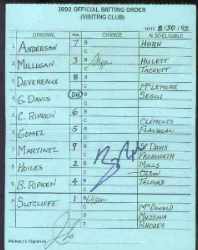Roger Clemens - 1997 Pacific Prism Light Blue #14 (Red Sox)


Please wander around the website for more info, prices, values & images
on vintage baseball, football, basketball, hockey, sport and non-sports cards.
Authentic Major League SIGNED |

1976 Popsicle Football Teams |

1971 O-Pee-Chee BaseballAlso referred to as OPC or Topps Canada, most vintage OPC sets were near replicas of the Topps cards from that year. Exactly same in design they usually only differed with the addition of French to the backs and some fronts.To the benefit of collector's OPC made several changes in their 1971 set. The most obvious and useful was a complete redesign of the card backs and the addition of another player photo ! Additionly, over 20 cards were changed including the inclusion of what could be considered the first "Traded" cards. Another difference: Topps cards #202 and #289 were changed to allow the addition of 2 more Expos to the set. The 1971 OPC set is legendary for its short print run, estimated at perhaps just 5% of Topps’ Production. This issue is considered quite elusive, even in Canada. TOP ROOKIE: Steve Garvey TOP STARS: Nolan Ryan, Roberto Clemente, Willie Mays, Hank Aaron, Ernie Banks, Pete Rose, Ted Williams, Thurman Munson, Reggie Jackson, Don Baylor/Dusty Baker RC & MORE !!!
Click for complete
1971 OPC/O-Pee-Chee Baseball checklist and prices
|

Starting approximately in 1886, sportscards, mostly baseball cards, were often included with tobacco products, for promotional purposes and also because the card reinforced the packaging and protected cigarettes from damage. These sports cards are referred to as tobacco cards in the baseball card hobby. Over the next few years many different companies produced baseball cards. Tobacco cards soon started to disappear as the American Tobacco Company tried to develop a monopoly by buying out other companies.
They were reintroduced in the 1900s, as American Tobacco came under pressure from antitrust action and Turkish competition. The most famous and most expensive, baseball card is the rare T206 Honus Wagner. The card exists in very limited quantities compared to others of its type because Wagner forced the card to be removed from printing. It is widely (and incorrectly) believed that Wagner did so because he refused to promote tobacco, but the true explanation lies in a dispute over compensation.
Soon other companies also began producing baseball and football cards. Sports magazines such as The Sporting News were early entries to the market. Candy manufacturers soon joined the fray and reflected a shift toward a younger target audience for cards. Caramel companies were particularly active and baseball cards were one of the first prizes to be included in Cracker Jacks. World War I soon suppressed baseball card production.
 These are the official lineup cards SIGNED BY THE MANAGER & given
to the home plate umpire before the game with the team's line-up
& batting order !!! Making them even neater, often managers made
lineup changes on these cards throughout the game.
These official lineup cards were SIGNED BY THE MANAGER and presented
to the home plate umpire before the game. They detailed the team's lineup and
batting order. Managers often made lineup changes on these cards throughout
the game, making them even more unique.
These are the official lineup cards SIGNED BY THE MANAGER & given
to the home plate umpire before the game with the team's line-up
& batting order !!! Making them even neater, often managers made
lineup changes on these cards throughout the game.
These official lineup cards were SIGNED BY THE MANAGER and presented
to the home plate umpire before the game. They detailed the team's lineup and
batting order. Managers often made lineup changes on these cards throughout
the game, making them even more unique.
